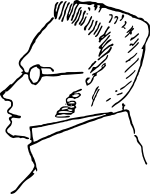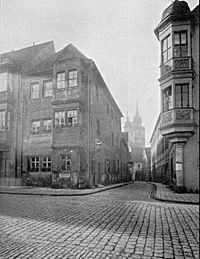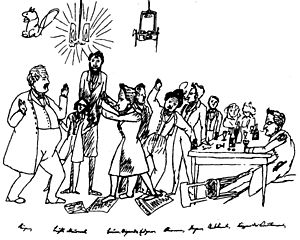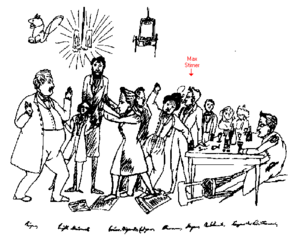Max Stirner facts for kids
Quick facts for kids
Max Stirner
|
|
|---|---|

Stirner as portrayed by Friedrich Engels
|
|
| Born |
Johann Kaspar Schmidt
25 October 1806 Bayreuth, Kingdom of Bavaria
|
| Died | 26 June 1856 (aged 49) |
| Education |
|
| Era | 19th-century philosophy |
| Region | Western philosophy |
| School |
|
|
Main interests
|
Egoism, ethics, ontology, pedagogy, philosophy of history, philosophy of religion, philosophy of education, property theory, psychology, value theory, philosophy of love, dialectic |
|
Notable ideas
|
|
Johann Kaspar Schmidt (born October 25, 1806 – died June 26, 1856), known as Max Stirner, was a German philosopher. He thought a lot about how people feel disconnected from society and how they understand themselves. Stirner is often seen as an early thinker for ideas like nihilism (the belief that life has no meaning), existentialism (focusing on individual freedom and responsibility), and individualist anarchism (a political idea that emphasizes individual freedom above all else).
Stirner's most famous book is The Ego and Its Own (in German, Der Einzige und sein Eigentum). It was first published in 1844 in Leipzig, Germany. This book has been printed many times and translated into different languages.
Contents
Max Stirner's Life Story
Max Stirner was born in Bayreuth, a city in Bavaria, Germany. We know about his life mostly thanks to a writer named John Henry Mackay. Mackay wrote a detailed book about Stirner's life.
Stirner was the only child of Albert Christian Heinrich Schmidt and Sophia Elenora Reinlein. His father passed away when Stirner was very young, in 1807. A few years later, his mother remarried and moved to a different part of Germany.
When Stirner was 20, he started studying at the University of Berlin. There, he listened to lectures by a famous philosopher named Georg Wilhelm Friedrich Hegel. Hegel's ideas greatly inspired Stirner's own thinking. Stirner also studied at the University of Erlangen.
After his studies, Stirner became a teacher. However, he couldn't get a full-time job with the government. In 1841, while in Berlin, Stirner joined a group of young philosophers called Die Freien (The Free Ones). These thinkers are now known as the Young Hegelians. Famous people like Karl Marx and Friedrich Engels were part of this group.
The group often met at a wine bar. Stirner met Engels many times, and Engels even said they were "great friends." It's not clear if Stirner and Marx ever met. Stirner didn't talk much in the group, but he listened carefully. The most common picture of Stirner is a drawing by Engels, made years later from memory.
Stirner worked as a teacher at a girls' school while writing his main book, The Ego and Its Own. This book argued against the ideas of other philosophers and thinkers of his time. He stopped teaching in October 1844.
Stirner was married twice. His first wife, Agnes Burtz, passed away in 1838. In 1843, he married Marie Dähnhardt, who was also part of the Die Freien group. Their wedding was very simple.
Using money Marie inherited, Stirner tried to start a business selling milk. But it didn't work out, and the business failed quickly. This caused problems between him and Marie, and they separated in 1847.
After The Ego and Its Own, Stirner wrote other works and translated books by famous economists like Adam Smith. He passed away in 1856 in Berlin from an infected insect bite.
Stirner's Philosophy
Stirner's main ideas are found in his book The Ego and Its Own. He is seen as a key figure in the development of nihilism, existentialism, and individualist anarchism.
Stirner was against many common ideas like communism and capitalism. He saw them as ways to control individuals. He believed that these systems, and even ideas like humanism and nationalism, put authority above the individual person.
He was not against people working together for a cause, but he was against blindly following ideas that were considered "sacred" or absolute truths.
What is Egoism?
Stirner's idea of egoism is about individuals being unique and impossible to fully understand. He believed that everyone is driven by their own desires. Those who accept this are "willing egoists" and can live freely. Those who don't are "unwilling egoists." They might think they are serving a higher cause, but they are still secretly fulfilling their own desires for happiness.
A "willing egoist" would realize they can act freely. They would not feel bound by rules like laws, rights, or religion if those rules don't serve their own unique self. Stirner believed that power is how an individual gets what they want. He didn't believe in natural rights, like the right to property. Instead, he encouraged people to challenge all forms of authority.
Anarchism and Individual Freedom
Stirner believed that many social institutions, like the state, the idea of natural rights, and even society itself, were just "illusions" or "ghosts" in our minds. He supported egoism and a way of thinking where individuals would only join together in "Unions of egoists" if it benefited them.
For Stirner, property simply comes from having the power to take and keep something. He said: "Whoever knows how to take and to defend the thing, to him belongs [property]." He believed that individuals should not respect others' property if it goes against their own interests. He saw the world and everything in it, including other people, as available for one's own use without moral limits. He thought that rights don't truly exist for objects or people.
Even though Stirner is often called an anarchist, some people argue that his ideas are separate from anarchism. However, his philosophy has greatly influenced many individualist anarchists.
Stirner on Communism
Stirner thought that communism had the same problems as religion. He believed it was based on ideas like morality and justice, which he saw as "superstitious." His main criticism of socialism and communism was that they ignored the individual. They aimed to give ownership to an abstract idea like "society," meaning no real person owned anything.
However, some anarchists believe that Stirner's ideas can still be useful to them. Stirner would likely agree, as he believed individuals should decide what is in their best interest.
Revolution vs. Insurrection
Stirner had a unique view on change. He criticized traditional ideas of revolution. He thought that revolutions often just replaced one set of rules with another.
Instead, he talked about "insurrection." This is not about changing the system, but about individuals changing themselves. He said: "Revolution aims at new arrangements; insurrection leads us no longer to let ourselves be arranged, but to arrange ourselves." It's about individuals breaking free from old ways of thinking and acting, rather than just overthrowing a government.
Union of Egoists
Stirner's idea of the Union of egoists is explained in The Ego and Its Own. This "Union" is a flexible group, different from a state. Unlike a "community" where people are forced to join, Stirner's Union would be completely voluntary. Individuals would join only if others in the Union were useful to them. The connection in a Union of egoists would continue only as long as everyone involved wanted it to.
Stirner's Writings
The False Principle of Our Education
In 1842, Stirner published The False Principle of Our Education. In this work, he argued that traditional education, whether focused on classical studies or practical skills, wasn't truly valuable. He believed that the goal of education should not just be knowledge. Instead, he called for education to help people become "free natures," focusing on the individual person.
The Ego and Its Own
Stirner's most important book, The Ego and Its Own, was published in 1844. In this book, Stirner strongly criticizes the society he lived in. He also criticizes modern Western society in general. He presents a view of human life where he sees himself as "the unique one." He calls himself a "creative nothing," meaning he is beyond what language can fully describe. He states that "All things are nothing to me" if he is focused on his unique self.
The book claims that all religions and political ideas are based on empty concepts. The same goes for institutions that claim power over individuals, like the state, laws, the church, or universities.
Stirner's Critics
Stirner's Critics was published in 1845. It was Stirner's response to three reviews of his main book, The Ego and Its Own. In this work, Stirner refers to himself in the third person.
History of Reaction
History of Reaction was published in two volumes in 1851. It was quickly banned in Austria. This book was written after the revolutions of 1848 in the German states. It is mostly a collection of other people's writings that Stirner selected and translated. Stirner wrote the introduction and some other parts.
Stirner's Influence
Even though The Ego and Its Own was popular when it first came out, it went out of print before Stirner passed away. However, after his death, it became popular again and has been published in many languages.
Many thinkers have read Stirner's book when they were young. These include Rudolf Steiner, Gustav Landauer, and Carl Schmitt. Some have tried to use Stirner's ideas to support capitalism, while others have used them to argue for anarcho-syndicalism (a type of anarchism focused on workers' unions).
Many other writers, philosophers, and artists have mentioned or referred to Max Stirner. These include Albert Camus, Benjamin Tucker, Emma Goldman, and Oscar Wilde.
Influence on Anarchism
Stirner's philosophy was very important for the development of modern anarchist thought. This is especially true for individualist anarchism and egoist anarchism. Even though he is linked to individualist anarchism, he also influenced many social anarchists, like anarcha-feminists Emma Goldman and Federica Montseny.
In Europe, he influenced important individualist anarchists like Émile Armand and Renzo Novatore. In America, his ideas were supported by Benjamin Tucker and his magazine Liberty.
Later, in the 1960s, Daniel Guérin wrote that Stirner "brought back the importance of the individual" at a time when philosophical ideas often went against individualism. In the United States, a group called For Ourselves published a book supporting "communist egoism" based on Stirner's ideas.
More recently, a type of anarchism called post-left anarchy has been deeply influenced by Stirner. Thinkers like Jason McQuinn and Bob Black use Stirner's egoism in their work. Insurrectionary anarchism also has a strong connection to Stirner's ideas.
Karl Marx and Friedrich Engels
Friedrich Engels wrote a poem about Stirner when they were part of Die Freien:
Look at Stirner, look at him, the peaceful enemy of all constraint.
For the moment, he is still drinking beer,
Soon he will be drinking blood as though it were water.
When others cry savagely "down with the kings"
Stirner immediately supplements "down with the laws also."
Engels once said they were "great friends." In 1844, Engels wrote to Karl Marx about Stirner's new book, The Ego and Its Own. Engels told Marx that Stirner "had obviously, among the 'Free Ones', the most talent, independence and diligence."
Later, Marx and Engels wrote a long and strong criticism of Stirner's work in their book The German Ideology. They made fun of Stirner in many pages of the book. This book was written in 1845–1846 but wasn't published until 1932. Many believe that Marx's strong arguments against Stirner helped Marx develop his own ideas from idealism to materialism.
Possible Influence on Friedrich Nietzsche
The ideas of Stirner and Friedrich Nietzsche are often compared because their writings seem similar. Many people have wondered if Nietzsche was influenced by Stirner. When Nietzsche became famous in Germany, Stirner was one of the most discussed thinkers in relation to his ideas.
Nietzsche likely read about The Ego and Its Own in other books he knew well. However, there is no clear proof that Nietzsche actually read Stirner's book himself. He never mentioned Stirner in his own writings or letters.
Despite this, the idea that Nietzsche was influenced by Stirner became very common in Germany around the turn of the century. Some even suggested that Nietzsche had copied Stirner's ideas.
However, there are also strong arguments against this influence. By the mid-20th century, many scholars dismissed the idea of Stirner's influence on Nietzsche. Still, some people continue to believe there was an influence, perhaps because of the noticeable similarities in their ideas. It's hard to know for sure if Stirner truly influenced a widely read philosopher like Nietzsche.
Rudolf Steiner
The early philosophy of Rudolf Steiner, before he became interested in theosophy, was similar to Stirner's ideas about the ego. Steiner himself said that Stirner's ideas influenced him.
Images for kids
See also
 In Spanish: Max Stirner para niños
In Spanish: Max Stirner para niños









